Consumer Behaviour: Individual Differences in National Bank of America
VerifiedAdded on 2023/04/21
|13
|4016
|131
Report
AI Summary
This report provides a comprehensive analysis of customer behavior at National Bank of America, focusing on the impact of individual difference factors such as technological changes, marketing campaigns, situational cues, economic factors, perception, learning, attitude, personality, needs, and trends on consumer purchase decisions and brand switching processes. The report examines how these factors influence the consumer decision-making process, including need recognition, information research, evaluation of alternatives, purchase decision, and post-purchase behavior. It also explores relevant customer behavior theories, such as the theory of reasoned action and the Engel, Kollet, Blackwell model, and discusses how marketers can apply this understanding to enhance marketing strategies. The analysis includes real-life examples, such as Amazon, to illustrate the influence of online competition on retail markets and consumer choices. The report concludes by emphasizing the importance of understanding individual differences to improve customer satisfaction and loyalty.
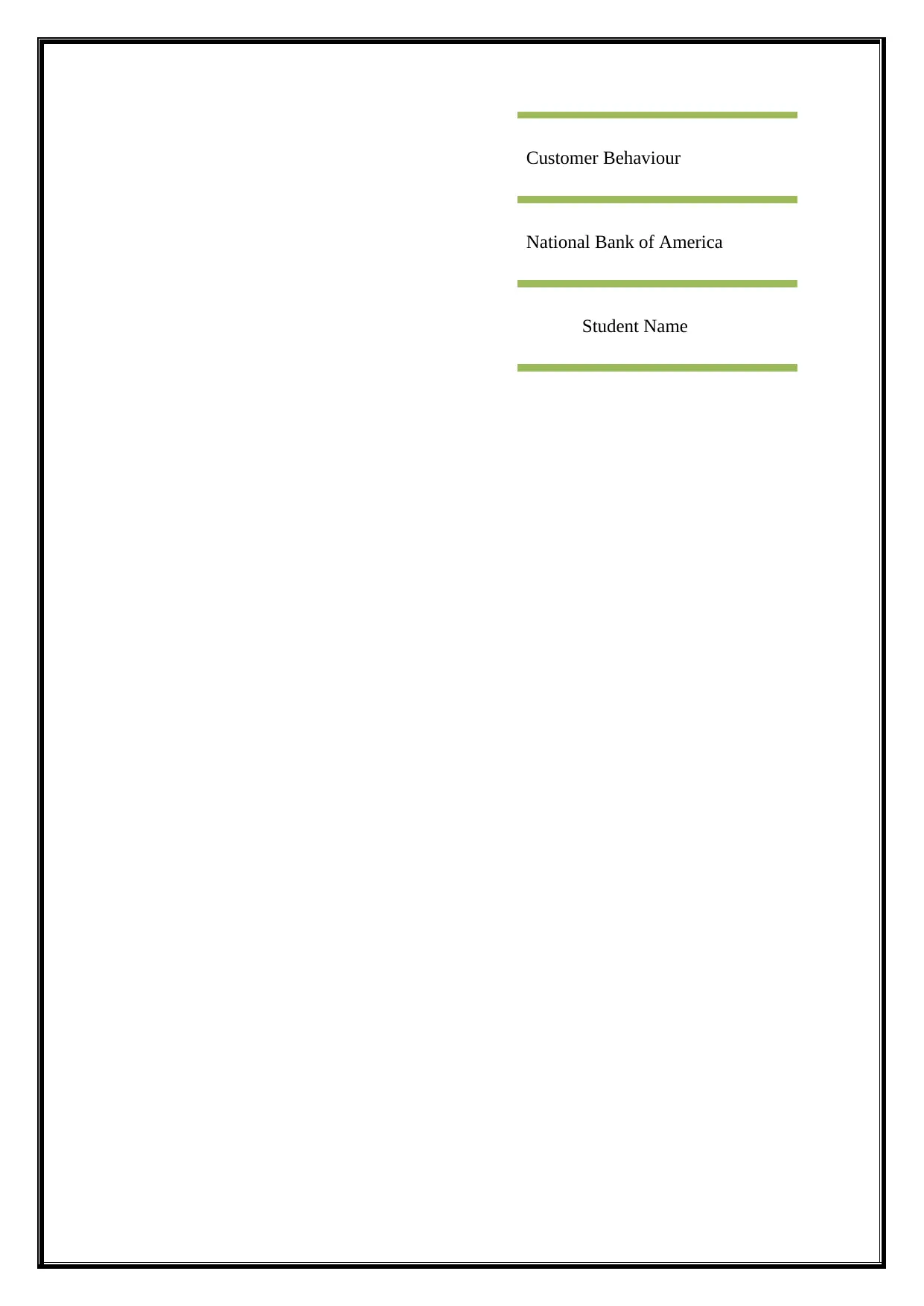
Customer Behaviour
National Bank of America
Student Name
National Bank of America
Student Name
Paraphrase This Document
Need a fresh take? Get an instant paraphrase of this document with our AI Paraphraser

Consumer Behaviour 1
Contents
Introduction....................................................................................................................2
Individual difference Influence factors:.....................................................................2
Impact of individual difference factor on consumer purchase decision and brand
switching process.......................................................................................................................3
Consumer decision making............................................................................................5
Influence of individual difference factors on consumers’ decision making process.....6
Real life example of amazon..........................................................................................6
Customer behaviour theories..........................................................................................7
Individual difference on consumer behaviour to enhance organisation-marketing
strategies….................................................................................................................................8
Conclusion......................................................................................................................9
References....................................................................................................................10
Contents
Introduction....................................................................................................................2
Individual difference Influence factors:.....................................................................2
Impact of individual difference factor on consumer purchase decision and brand
switching process.......................................................................................................................3
Consumer decision making............................................................................................5
Influence of individual difference factors on consumers’ decision making process.....6
Real life example of amazon..........................................................................................6
Customer behaviour theories..........................................................................................7
Individual difference on consumer behaviour to enhance organisation-marketing
strategies….................................................................................................................................8
Conclusion......................................................................................................................9
References....................................................................................................................10
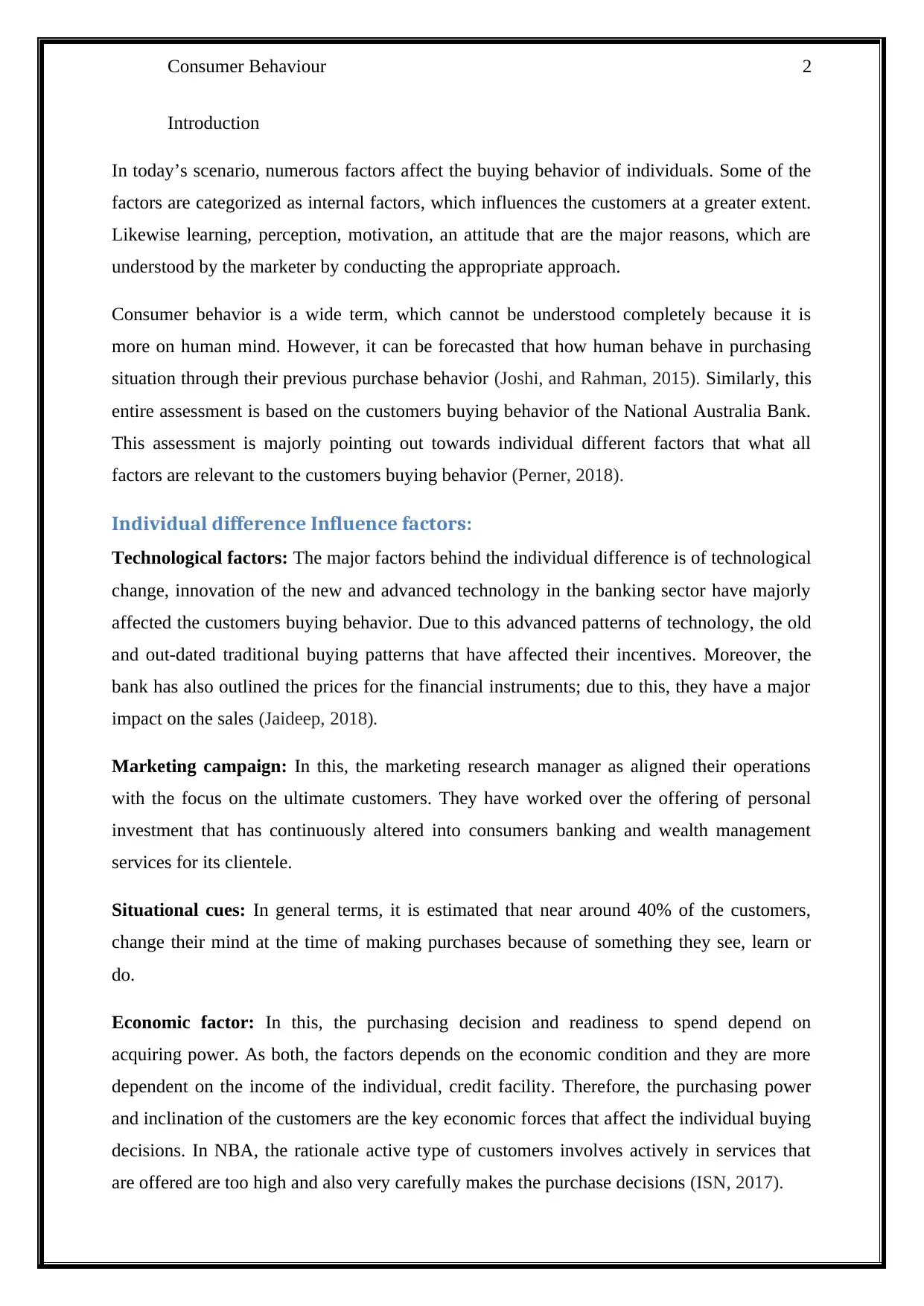
Consumer Behaviour 2
Introduction
In today’s scenario, numerous factors affect the buying behavior of individuals. Some of the
factors are categorized as internal factors, which influences the customers at a greater extent.
Likewise learning, perception, motivation, an attitude that are the major reasons, which are
understood by the marketer by conducting the appropriate approach.
Consumer behavior is a wide term, which cannot be understood completely because it is
more on human mind. However, it can be forecasted that how human behave in purchasing
situation through their previous purchase behavior (Joshi, and Rahman, 2015). Similarly, this
entire assessment is based on the customers buying behavior of the National Australia Bank.
This assessment is majorly pointing out towards individual different factors that what all
factors are relevant to the customers buying behavior (Perner, 2018).
Individual difference Influence factors:
Technological factors: The major factors behind the individual difference is of technological
change, innovation of the new and advanced technology in the banking sector have majorly
affected the customers buying behavior. Due to this advanced patterns of technology, the old
and out-dated traditional buying patterns that have affected their incentives. Moreover, the
bank has also outlined the prices for the financial instruments; due to this, they have a major
impact on the sales (Jaideep, 2018).
Marketing campaign: In this, the marketing research manager as aligned their operations
with the focus on the ultimate customers. They have worked over the offering of personal
investment that has continuously altered into consumers banking and wealth management
services for its clientele.
Situational cues: In general terms, it is estimated that near around 40% of the customers,
change their mind at the time of making purchases because of something they see, learn or
do.
Economic factor: In this, the purchasing decision and readiness to spend depend on
acquiring power. As both, the factors depends on the economic condition and they are more
dependent on the income of the individual, credit facility. Therefore, the purchasing power
and inclination of the customers are the key economic forces that affect the individual buying
decisions. In NBA, the rationale active type of customers involves actively in services that
are offered are too high and also very carefully makes the purchase decisions (ISN, 2017).
Introduction
In today’s scenario, numerous factors affect the buying behavior of individuals. Some of the
factors are categorized as internal factors, which influences the customers at a greater extent.
Likewise learning, perception, motivation, an attitude that are the major reasons, which are
understood by the marketer by conducting the appropriate approach.
Consumer behavior is a wide term, which cannot be understood completely because it is
more on human mind. However, it can be forecasted that how human behave in purchasing
situation through their previous purchase behavior (Joshi, and Rahman, 2015). Similarly, this
entire assessment is based on the customers buying behavior of the National Australia Bank.
This assessment is majorly pointing out towards individual different factors that what all
factors are relevant to the customers buying behavior (Perner, 2018).
Individual difference Influence factors:
Technological factors: The major factors behind the individual difference is of technological
change, innovation of the new and advanced technology in the banking sector have majorly
affected the customers buying behavior. Due to this advanced patterns of technology, the old
and out-dated traditional buying patterns that have affected their incentives. Moreover, the
bank has also outlined the prices for the financial instruments; due to this, they have a major
impact on the sales (Jaideep, 2018).
Marketing campaign: In this, the marketing research manager as aligned their operations
with the focus on the ultimate customers. They have worked over the offering of personal
investment that has continuously altered into consumers banking and wealth management
services for its clientele.
Situational cues: In general terms, it is estimated that near around 40% of the customers,
change their mind at the time of making purchases because of something they see, learn or
do.
Economic factor: In this, the purchasing decision and readiness to spend depend on
acquiring power. As both, the factors depends on the economic condition and they are more
dependent on the income of the individual, credit facility. Therefore, the purchasing power
and inclination of the customers are the key economic forces that affect the individual buying
decisions. In NBA, the rationale active type of customers involves actively in services that
are offered are too high and also very carefully makes the purchase decisions (ISN, 2017).
⊘ This is a preview!⊘
Do you want full access?
Subscribe today to unlock all pages.

Trusted by 1+ million students worldwide
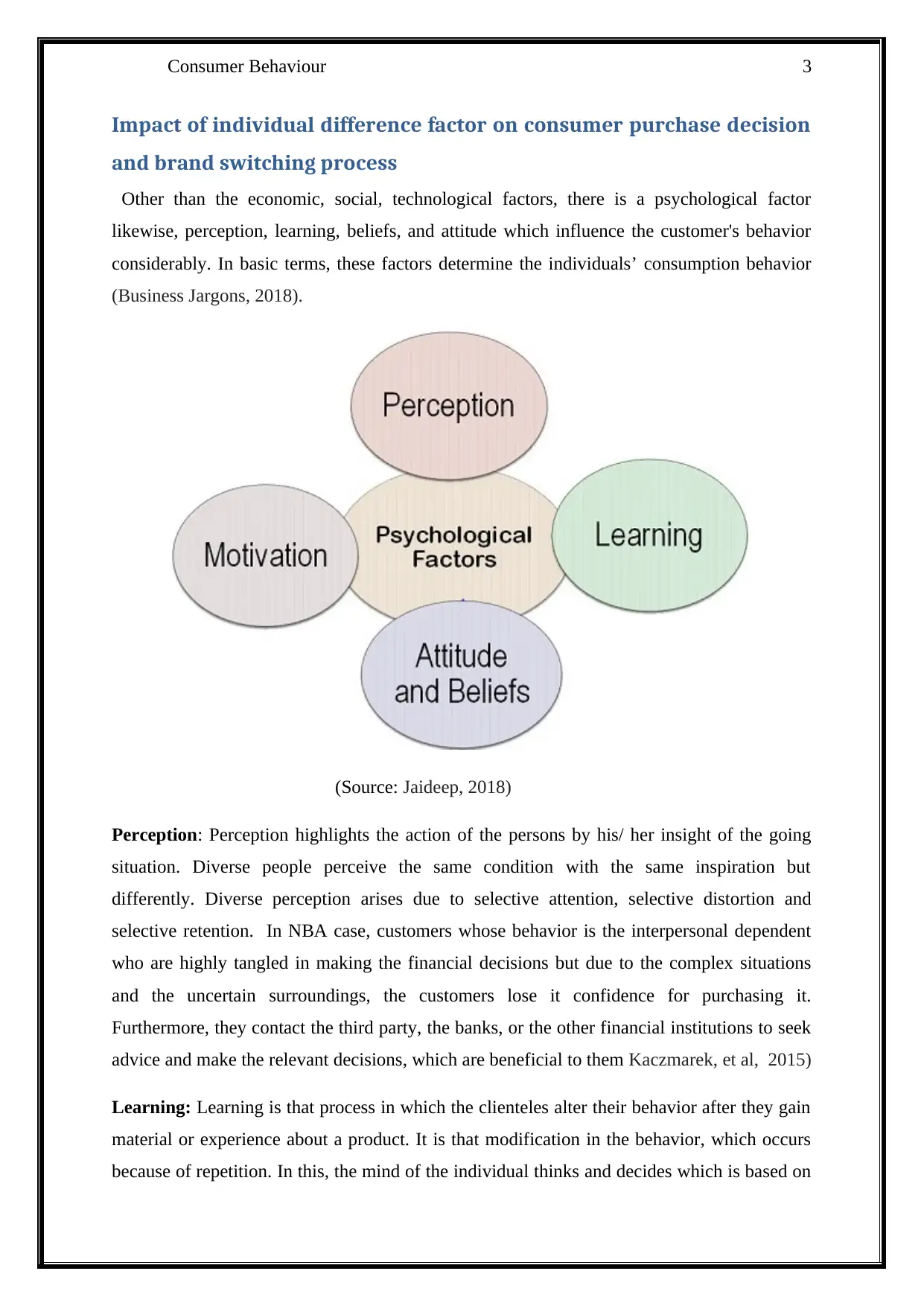
Consumer Behaviour 3
Impact of individual difference factor on consumer purchase decision
and brand switching process
Other than the economic, social, technological factors, there is a psychological factor
likewise, perception, learning, beliefs, and attitude which influence the customer's behavior
considerably. In basic terms, these factors determine the individuals’ consumption behavior
(Business Jargons, 2018).
(Source: Jaideep, 2018)
Perception: Perception highlights the action of the persons by his/ her insight of the going
situation. Diverse people perceive the same condition with the same inspiration but
differently. Diverse perception arises due to selective attention, selective distortion and
selective retention. In NBA case, customers whose behavior is the interpersonal dependent
who are highly tangled in making the financial decisions but due to the complex situations
and the uncertain surroundings, the customers lose it confidence for purchasing it.
Furthermore, they contact the third party, the banks, or the other financial institutions to seek
advice and make the relevant decisions, which are beneficial to them Kaczmarek, et al, 2015)
Learning: Learning is that process in which the clienteles alter their behavior after they gain
material or experience about a product. It is that modification in the behavior, which occurs
because of repetition. In this, the mind of the individual thinks and decides which is based on
Impact of individual difference factor on consumer purchase decision
and brand switching process
Other than the economic, social, technological factors, there is a psychological factor
likewise, perception, learning, beliefs, and attitude which influence the customer's behavior
considerably. In basic terms, these factors determine the individuals’ consumption behavior
(Business Jargons, 2018).
(Source: Jaideep, 2018)
Perception: Perception highlights the action of the persons by his/ her insight of the going
situation. Diverse people perceive the same condition with the same inspiration but
differently. Diverse perception arises due to selective attention, selective distortion and
selective retention. In NBA case, customers whose behavior is the interpersonal dependent
who are highly tangled in making the financial decisions but due to the complex situations
and the uncertain surroundings, the customers lose it confidence for purchasing it.
Furthermore, they contact the third party, the banks, or the other financial institutions to seek
advice and make the relevant decisions, which are beneficial to them Kaczmarek, et al, 2015)
Learning: Learning is that process in which the clienteles alter their behavior after they gain
material or experience about a product. It is that modification in the behavior, which occurs
because of repetition. In this, the mind of the individual thinks and decides which is based on
Paraphrase This Document
Need a fresh take? Get an instant paraphrase of this document with our AI Paraphraser

Consumer Behaviour 4
the understanding and then the individuals’ performances accordingly. According to the
NBA, in this the customers who are having less knowledge about the financial terms, they
seek advice from the various financial institutions, third party or the other individuals who
are more active in this course. Through all this, the get to know more about the financial
terms, in basic terms the learn about the financial jargons and make investments and doings
in the bank accordingly (Shukla, 2009).
Attitude: Attitude is that state of mind or mental positions, an emotional feeling which
people have about the products, services, companies, ideas, issues, or the institutions.
Attitude tends to be enduring, which are mainly based on people’s values, beliefs that are
hard to change. Change in attitude in the banking concern is a good example. With the
change in the technological environment, an individual is having change in their attitude and
buying behavior (Shamim, Ghazali, and Albinsson, 2016). Likewise, in the NBA case, due to
the innovation of new technologies, customers’ behavior was highly impacted. They are now
shifting from tradition to modern techniques highlights their behavior.
Personality: personality highlights all the internal traits and behavior that make a person
unique. In another term, a person’s personality and the factors are related to his/her
“uniqueness” Some of the trait characteristics highlights about personality are confidence,
individualism, friendliness, adaptability, workaholic, aggressiveness, competitiveness. In
NBA case, there is four types of personality are highlighted of the individuals one are the
repeat- passive customers, which displays poor participation in the monetary aspects despite
being alert of the silent features of the accessible products. Secondly, some of the
personalities are passive in nature, which makes repetitive transactions with the same
products without knowing about the alternatives (Chamorro-Premuzic, 2016).
Needs: According to the needs perspective, numerous factors affect the customers buying
behavior and the purchase decisions. Needs can be changed according to the age. The needs
are also different. For example, when we enter into adulthood, our life becomes more
complex and with time, our needs become more complex. In recent years, old age brings us
back to demands that are more fundamental. Other than this, culture is also the factor, which
affects the needs of the customers. Culture aspect largely determines the individuals’ way of
being and the decisions they make (Singh, Verma, and Rao, 2017). In the NBA case,
individuals’ preferences will change according to their needs and choices. People who are
the understanding and then the individuals’ performances accordingly. According to the
NBA, in this the customers who are having less knowledge about the financial terms, they
seek advice from the various financial institutions, third party or the other individuals who
are more active in this course. Through all this, the get to know more about the financial
terms, in basic terms the learn about the financial jargons and make investments and doings
in the bank accordingly (Shukla, 2009).
Attitude: Attitude is that state of mind or mental positions, an emotional feeling which
people have about the products, services, companies, ideas, issues, or the institutions.
Attitude tends to be enduring, which are mainly based on people’s values, beliefs that are
hard to change. Change in attitude in the banking concern is a good example. With the
change in the technological environment, an individual is having change in their attitude and
buying behavior (Shamim, Ghazali, and Albinsson, 2016). Likewise, in the NBA case, due to
the innovation of new technologies, customers’ behavior was highly impacted. They are now
shifting from tradition to modern techniques highlights their behavior.
Personality: personality highlights all the internal traits and behavior that make a person
unique. In another term, a person’s personality and the factors are related to his/her
“uniqueness” Some of the trait characteristics highlights about personality are confidence,
individualism, friendliness, adaptability, workaholic, aggressiveness, competitiveness. In
NBA case, there is four types of personality are highlighted of the individuals one are the
repeat- passive customers, which displays poor participation in the monetary aspects despite
being alert of the silent features of the accessible products. Secondly, some of the
personalities are passive in nature, which makes repetitive transactions with the same
products without knowing about the alternatives (Chamorro-Premuzic, 2016).
Needs: According to the needs perspective, numerous factors affect the customers buying
behavior and the purchase decisions. Needs can be changed according to the age. The needs
are also different. For example, when we enter into adulthood, our life becomes more
complex and with time, our needs become more complex. In recent years, old age brings us
back to demands that are more fundamental. Other than this, culture is also the factor, which
affects the needs of the customers. Culture aspect largely determines the individuals’ way of
being and the decisions they make (Singh, Verma, and Rao, 2017). In the NBA case,
individuals’ preferences will change according to their needs and choices. People who are
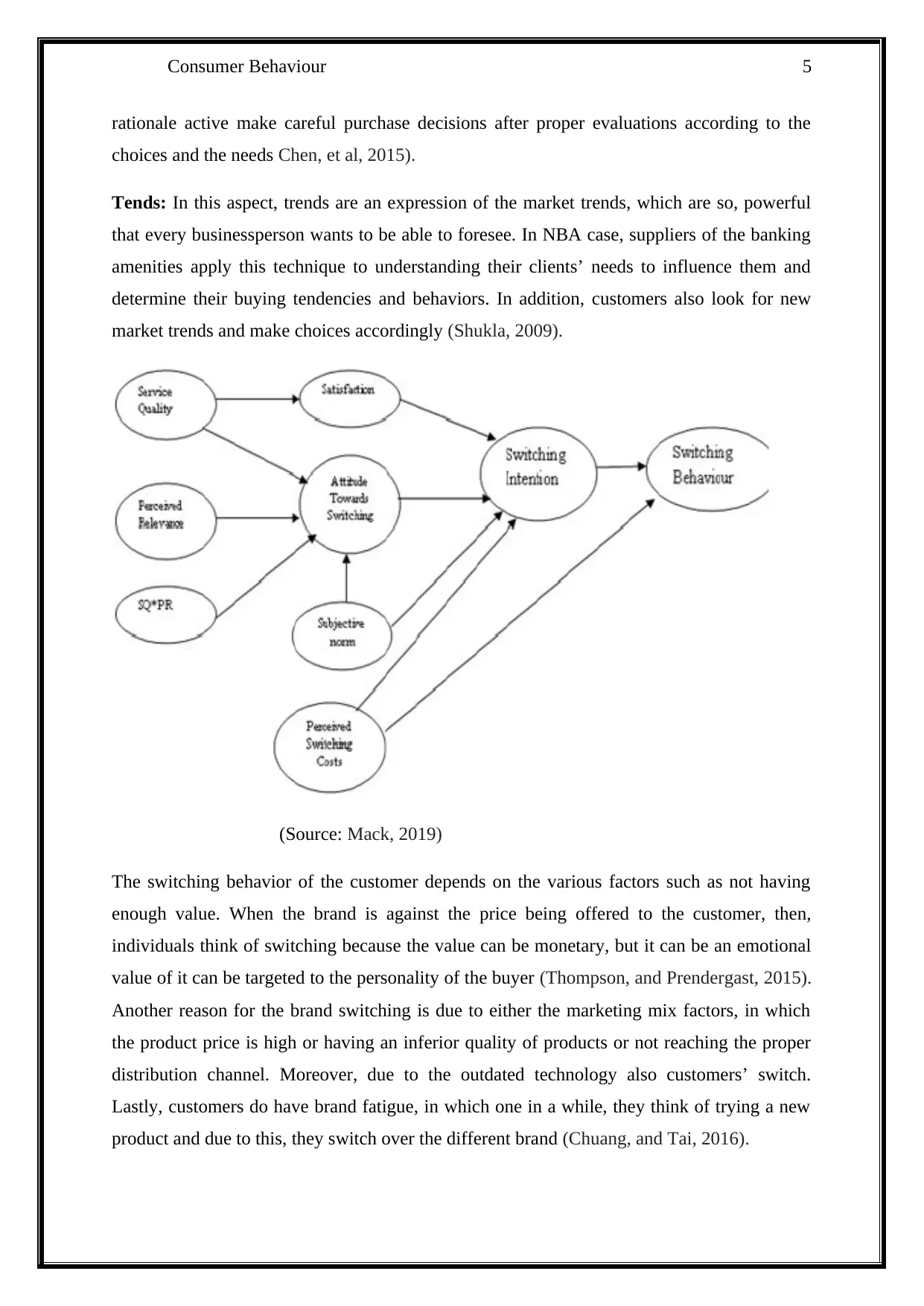
Consumer Behaviour 5
rationale active make careful purchase decisions after proper evaluations according to the
choices and the needs Chen, et al, 2015).
Tends: In this aspect, trends are an expression of the market trends, which are so, powerful
that every businessperson wants to be able to foresee. In NBA case, suppliers of the banking
amenities apply this technique to understanding their clients’ needs to influence them and
determine their buying tendencies and behaviors. In addition, customers also look for new
market trends and make choices accordingly (Shukla, 2009).
(Source: Mack, 2019)
The switching behavior of the customer depends on the various factors such as not having
enough value. When the brand is against the price being offered to the customer, then,
individuals think of switching because the value can be monetary, but it can be an emotional
value of it can be targeted to the personality of the buyer (Thompson, and Prendergast, 2015).
Another reason for the brand switching is due to either the marketing mix factors, in which
the product price is high or having an inferior quality of products or not reaching the proper
distribution channel. Moreover, due to the outdated technology also customers’ switch.
Lastly, customers do have brand fatigue, in which one in a while, they think of trying a new
product and due to this, they switch over the different brand (Chuang, and Tai, 2016).
rationale active make careful purchase decisions after proper evaluations according to the
choices and the needs Chen, et al, 2015).
Tends: In this aspect, trends are an expression of the market trends, which are so, powerful
that every businessperson wants to be able to foresee. In NBA case, suppliers of the banking
amenities apply this technique to understanding their clients’ needs to influence them and
determine their buying tendencies and behaviors. In addition, customers also look for new
market trends and make choices accordingly (Shukla, 2009).
(Source: Mack, 2019)
The switching behavior of the customer depends on the various factors such as not having
enough value. When the brand is against the price being offered to the customer, then,
individuals think of switching because the value can be monetary, but it can be an emotional
value of it can be targeted to the personality of the buyer (Thompson, and Prendergast, 2015).
Another reason for the brand switching is due to either the marketing mix factors, in which
the product price is high or having an inferior quality of products or not reaching the proper
distribution channel. Moreover, due to the outdated technology also customers’ switch.
Lastly, customers do have brand fatigue, in which one in a while, they think of trying a new
product and due to this, they switch over the different brand (Chuang, and Tai, 2016).
⊘ This is a preview!⊘
Do you want full access?
Subscribe today to unlock all pages.

Trusted by 1+ million students worldwide
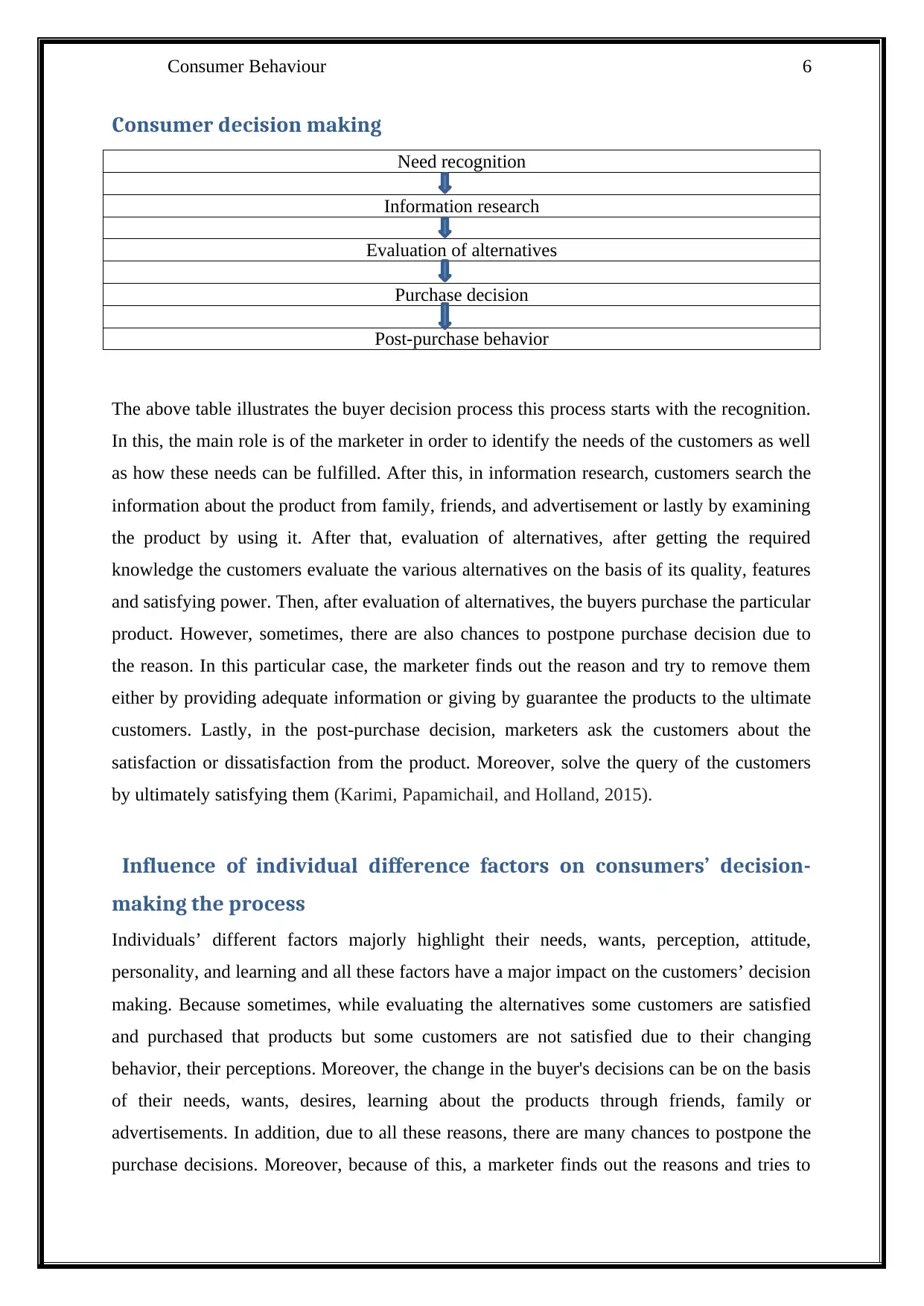
Consumer Behaviour 6
Consumer decision making
Need recognition
Information research
Evaluation of alternatives
Purchase decision
Post-purchase behavior
The above table illustrates the buyer decision process this process starts with the recognition.
In this, the main role is of the marketer in order to identify the needs of the customers as well
as how these needs can be fulfilled. After this, in information research, customers search the
information about the product from family, friends, and advertisement or lastly by examining
the product by using it. After that, evaluation of alternatives, after getting the required
knowledge the customers evaluate the various alternatives on the basis of its quality, features
and satisfying power. Then, after evaluation of alternatives, the buyers purchase the particular
product. However, sometimes, there are also chances to postpone purchase decision due to
the reason. In this particular case, the marketer finds out the reason and try to remove them
either by providing adequate information or giving by guarantee the products to the ultimate
customers. Lastly, in the post-purchase decision, marketers ask the customers about the
satisfaction or dissatisfaction from the product. Moreover, solve the query of the customers
by ultimately satisfying them (Karimi, Papamichail, and Holland, 2015).
Influence of individual difference factors on consumers’ decision-
making the process
Individuals’ different factors majorly highlight their needs, wants, perception, attitude,
personality, and learning and all these factors have a major impact on the customers’ decision
making. Because sometimes, while evaluating the alternatives some customers are satisfied
and purchased that products but some customers are not satisfied due to their changing
behavior, their perceptions. Moreover, the change in the buyer's decisions can be on the basis
of their needs, wants, desires, learning about the products through friends, family or
advertisements. In addition, due to all these reasons, there are many chances to postpone the
purchase decisions. Moreover, because of this, a marketer finds out the reasons and tries to
Consumer decision making
Need recognition
Information research
Evaluation of alternatives
Purchase decision
Post-purchase behavior
The above table illustrates the buyer decision process this process starts with the recognition.
In this, the main role is of the marketer in order to identify the needs of the customers as well
as how these needs can be fulfilled. After this, in information research, customers search the
information about the product from family, friends, and advertisement or lastly by examining
the product by using it. After that, evaluation of alternatives, after getting the required
knowledge the customers evaluate the various alternatives on the basis of its quality, features
and satisfying power. Then, after evaluation of alternatives, the buyers purchase the particular
product. However, sometimes, there are also chances to postpone purchase decision due to
the reason. In this particular case, the marketer finds out the reason and try to remove them
either by providing adequate information or giving by guarantee the products to the ultimate
customers. Lastly, in the post-purchase decision, marketers ask the customers about the
satisfaction or dissatisfaction from the product. Moreover, solve the query of the customers
by ultimately satisfying them (Karimi, Papamichail, and Holland, 2015).
Influence of individual difference factors on consumers’ decision-
making the process
Individuals’ different factors majorly highlight their needs, wants, perception, attitude,
personality, and learning and all these factors have a major impact on the customers’ decision
making. Because sometimes, while evaluating the alternatives some customers are satisfied
and purchased that products but some customers are not satisfied due to their changing
behavior, their perceptions. Moreover, the change in the buyer's decisions can be on the basis
of their needs, wants, desires, learning about the products through friends, family or
advertisements. In addition, due to all these reasons, there are many chances to postpone the
purchase decisions. Moreover, because of this, a marketer finds out the reasons and tries to
Paraphrase This Document
Need a fresh take? Get an instant paraphrase of this document with our AI Paraphraser
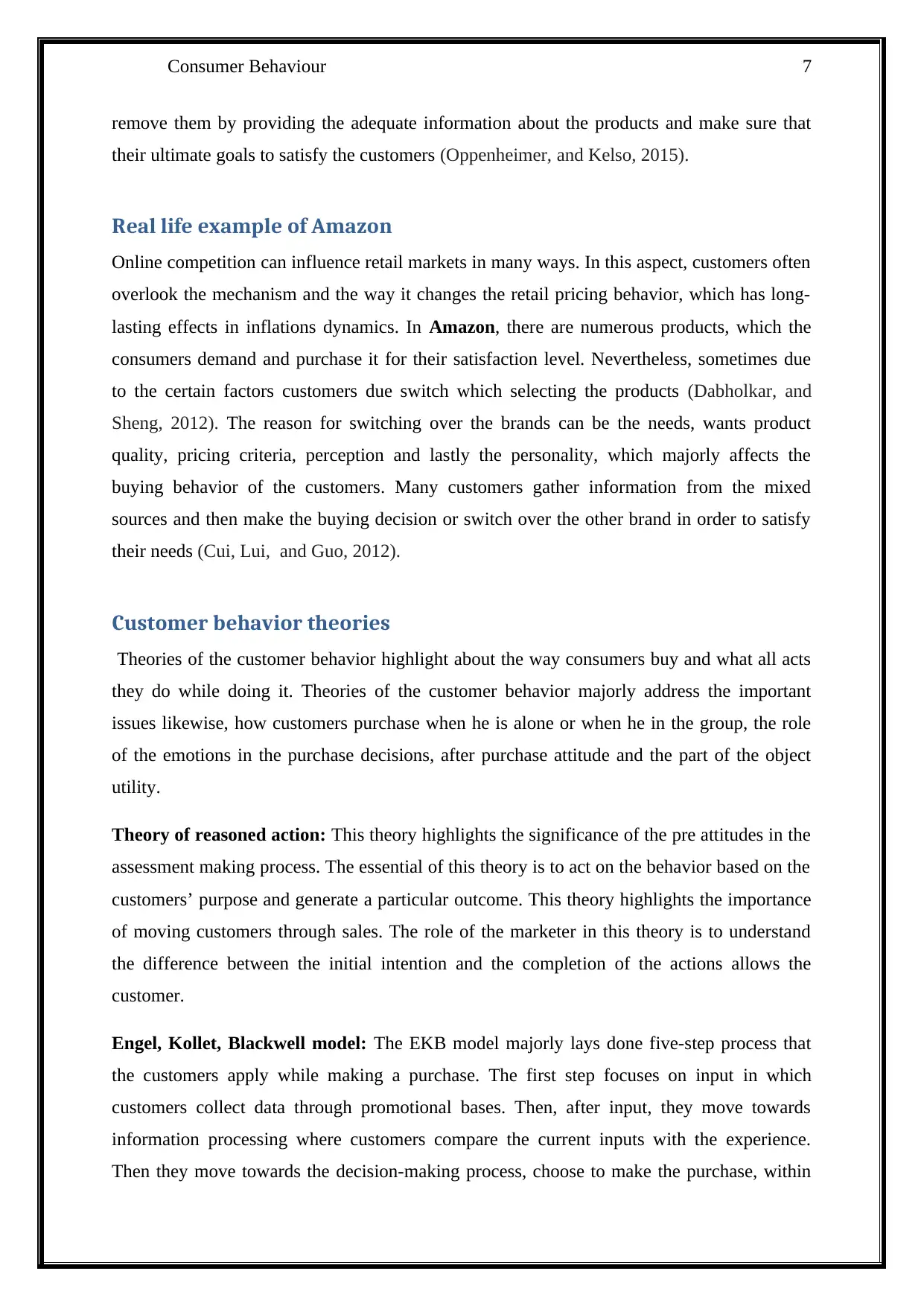
Consumer Behaviour 7
remove them by providing the adequate information about the products and make sure that
their ultimate goals to satisfy the customers (Oppenheimer, and Kelso, 2015).
Real life example of Amazon
Online competition can influence retail markets in many ways. In this aspect, customers often
overlook the mechanism and the way it changes the retail pricing behavior, which has long-
lasting effects in inflations dynamics. In Amazon, there are numerous products, which the
consumers demand and purchase it for their satisfaction level. Nevertheless, sometimes due
to the certain factors customers due switch which selecting the products (Dabholkar, and
Sheng, 2012). The reason for switching over the brands can be the needs, wants product
quality, pricing criteria, perception and lastly the personality, which majorly affects the
buying behavior of the customers. Many customers gather information from the mixed
sources and then make the buying decision or switch over the other brand in order to satisfy
their needs (Cui, Lui, and Guo, 2012).
Customer behavior theories
Theories of the customer behavior highlight about the way consumers buy and what all acts
they do while doing it. Theories of the customer behavior majorly address the important
issues likewise, how customers purchase when he is alone or when he in the group, the role
of the emotions in the purchase decisions, after purchase attitude and the part of the object
utility.
Theory of reasoned action: This theory highlights the significance of the pre attitudes in the
assessment making process. The essential of this theory is to act on the behavior based on the
customers’ purpose and generate a particular outcome. This theory highlights the importance
of moving customers through sales. The role of the marketer in this theory is to understand
the difference between the initial intention and the completion of the actions allows the
customer.
Engel, Kollet, Blackwell model: The EKB model majorly lays done five-step process that
the customers apply while making a purchase. The first step focuses on input in which
customers collect data through promotional bases. Then, after input, they move towards
information processing where customers compare the current inputs with the experience.
Then they move towards the decision-making process, choose to make the purchase, within
remove them by providing the adequate information about the products and make sure that
their ultimate goals to satisfy the customers (Oppenheimer, and Kelso, 2015).
Real life example of Amazon
Online competition can influence retail markets in many ways. In this aspect, customers often
overlook the mechanism and the way it changes the retail pricing behavior, which has long-
lasting effects in inflations dynamics. In Amazon, there are numerous products, which the
consumers demand and purchase it for their satisfaction level. Nevertheless, sometimes due
to the certain factors customers due switch which selecting the products (Dabholkar, and
Sheng, 2012). The reason for switching over the brands can be the needs, wants product
quality, pricing criteria, perception and lastly the personality, which majorly affects the
buying behavior of the customers. Many customers gather information from the mixed
sources and then make the buying decision or switch over the other brand in order to satisfy
their needs (Cui, Lui, and Guo, 2012).
Customer behavior theories
Theories of the customer behavior highlight about the way consumers buy and what all acts
they do while doing it. Theories of the customer behavior majorly address the important
issues likewise, how customers purchase when he is alone or when he in the group, the role
of the emotions in the purchase decisions, after purchase attitude and the part of the object
utility.
Theory of reasoned action: This theory highlights the significance of the pre attitudes in the
assessment making process. The essential of this theory is to act on the behavior based on the
customers’ purpose and generate a particular outcome. This theory highlights the importance
of moving customers through sales. The role of the marketer in this theory is to understand
the difference between the initial intention and the completion of the actions allows the
customer.
Engel, Kollet, Blackwell model: The EKB model majorly lays done five-step process that
the customers apply while making a purchase. The first step focuses on input in which
customers collect data through promotional bases. Then, after input, they move towards
information processing where customers compare the current inputs with the experience.
Then they move towards the decision-making process, choose to make the purchase, within
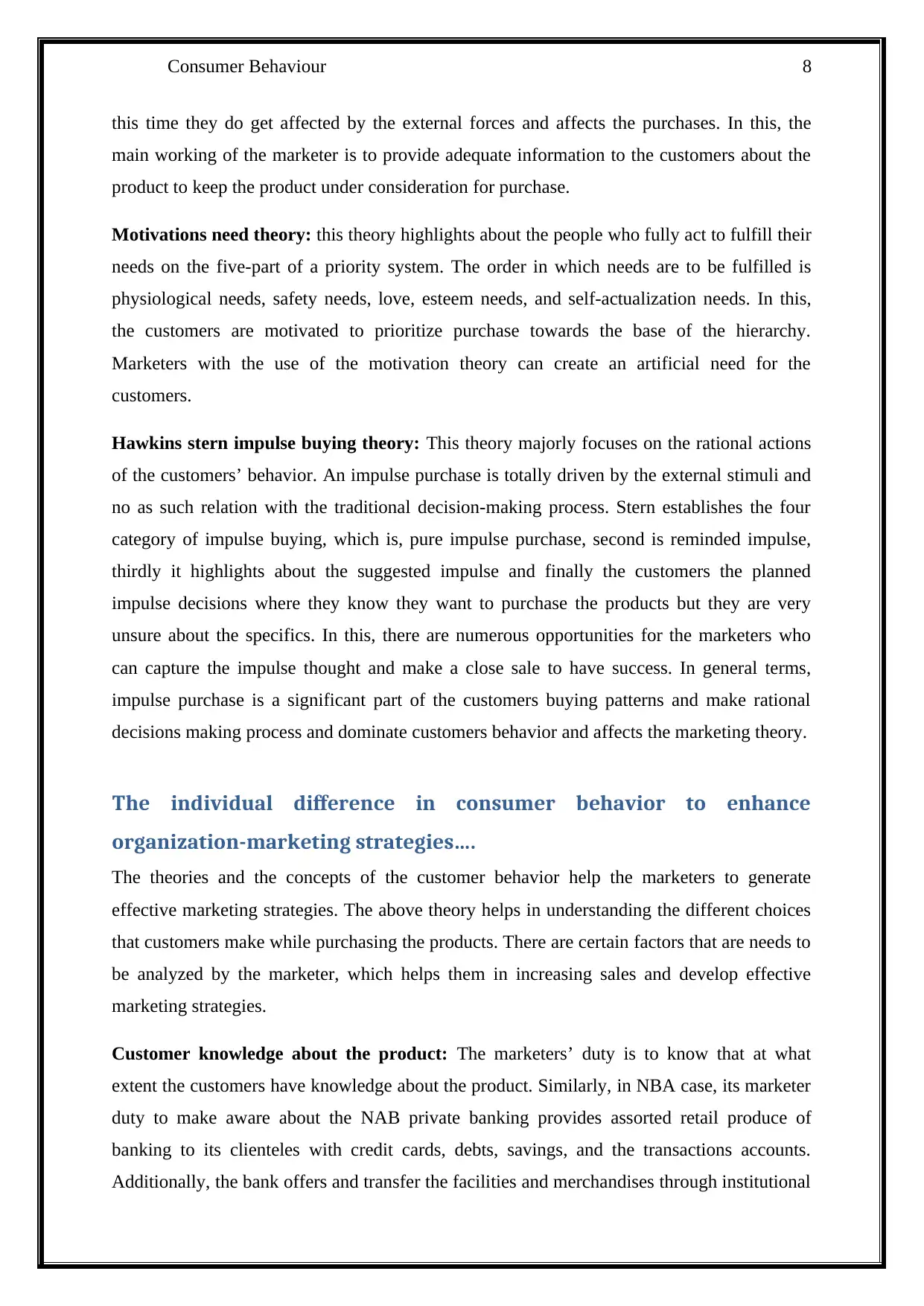
Consumer Behaviour 8
this time they do get affected by the external forces and affects the purchases. In this, the
main working of the marketer is to provide adequate information to the customers about the
product to keep the product under consideration for purchase.
Motivations need theory: this theory highlights about the people who fully act to fulfill their
needs on the five-part of a priority system. The order in which needs are to be fulfilled is
physiological needs, safety needs, love, esteem needs, and self-actualization needs. In this,
the customers are motivated to prioritize purchase towards the base of the hierarchy.
Marketers with the use of the motivation theory can create an artificial need for the
customers.
Hawkins stern impulse buying theory: This theory majorly focuses on the rational actions
of the customers’ behavior. An impulse purchase is totally driven by the external stimuli and
no as such relation with the traditional decision-making process. Stern establishes the four
category of impulse buying, which is, pure impulse purchase, second is reminded impulse,
thirdly it highlights about the suggested impulse and finally the customers the planned
impulse decisions where they know they want to purchase the products but they are very
unsure about the specifics. In this, there are numerous opportunities for the marketers who
can capture the impulse thought and make a close sale to have success. In general terms,
impulse purchase is a significant part of the customers buying patterns and make rational
decisions making process and dominate customers behavior and affects the marketing theory.
The individual difference in consumer behavior to enhance
organization-marketing strategies….
The theories and the concepts of the customer behavior help the marketers to generate
effective marketing strategies. The above theory helps in understanding the different choices
that customers make while purchasing the products. There are certain factors that are needs to
be analyzed by the marketer, which helps them in increasing sales and develop effective
marketing strategies.
Customer knowledge about the product: The marketers’ duty is to know that at what
extent the customers have knowledge about the product. Similarly, in NBA case, its marketer
duty to make aware about the NAB private banking provides assorted retail produce of
banking to its clienteles with credit cards, debts, savings, and the transactions accounts.
Additionally, the bank offers and transfer the facilities and merchandises through institutional
this time they do get affected by the external forces and affects the purchases. In this, the
main working of the marketer is to provide adequate information to the customers about the
product to keep the product under consideration for purchase.
Motivations need theory: this theory highlights about the people who fully act to fulfill their
needs on the five-part of a priority system. The order in which needs are to be fulfilled is
physiological needs, safety needs, love, esteem needs, and self-actualization needs. In this,
the customers are motivated to prioritize purchase towards the base of the hierarchy.
Marketers with the use of the motivation theory can create an artificial need for the
customers.
Hawkins stern impulse buying theory: This theory majorly focuses on the rational actions
of the customers’ behavior. An impulse purchase is totally driven by the external stimuli and
no as such relation with the traditional decision-making process. Stern establishes the four
category of impulse buying, which is, pure impulse purchase, second is reminded impulse,
thirdly it highlights about the suggested impulse and finally the customers the planned
impulse decisions where they know they want to purchase the products but they are very
unsure about the specifics. In this, there are numerous opportunities for the marketers who
can capture the impulse thought and make a close sale to have success. In general terms,
impulse purchase is a significant part of the customers buying patterns and make rational
decisions making process and dominate customers behavior and affects the marketing theory.
The individual difference in consumer behavior to enhance
organization-marketing strategies….
The theories and the concepts of the customer behavior help the marketers to generate
effective marketing strategies. The above theory helps in understanding the different choices
that customers make while purchasing the products. There are certain factors that are needs to
be analyzed by the marketer, which helps them in increasing sales and develop effective
marketing strategies.
Customer knowledge about the product: The marketers’ duty is to know that at what
extent the customers have knowledge about the product. Similarly, in NBA case, its marketer
duty to make aware about the NAB private banking provides assorted retail produce of
banking to its clienteles with credit cards, debts, savings, and the transactions accounts.
Additionally, the bank offers and transfer the facilities and merchandises through institutional
⊘ This is a preview!⊘
Do you want full access?
Subscribe today to unlock all pages.

Trusted by 1+ million students worldwide
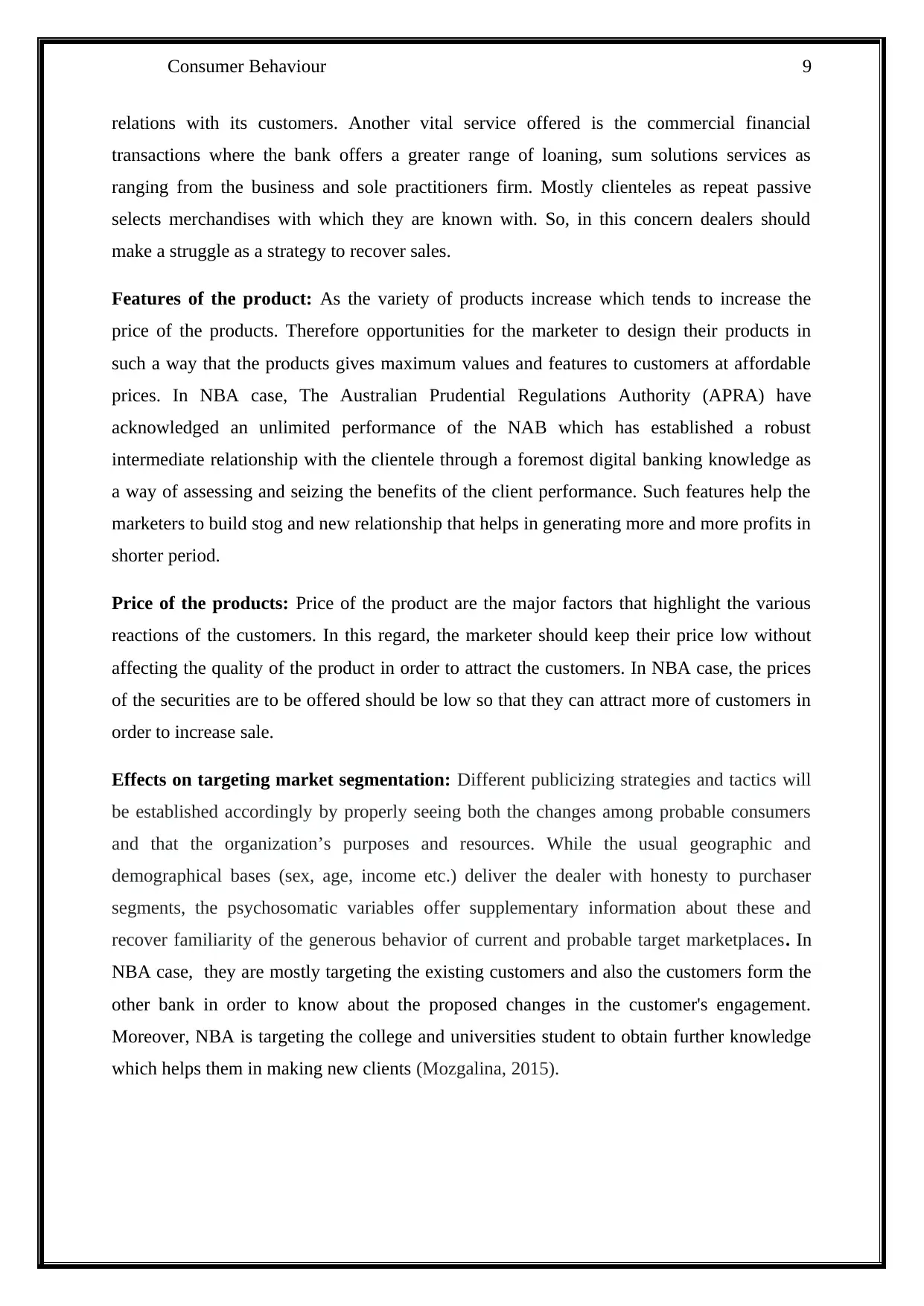
Consumer Behaviour 9
relations with its customers. Another vital service offered is the commercial financial
transactions where the bank offers a greater range of loaning, sum solutions services as
ranging from the business and sole practitioners firm. Mostly clienteles as repeat passive
selects merchandises with which they are known with. So, in this concern dealers should
make a struggle as a strategy to recover sales.
Features of the product: As the variety of products increase which tends to increase the
price of the products. Therefore opportunities for the marketer to design their products in
such a way that the products gives maximum values and features to customers at affordable
prices. In NBA case, The Australian Prudential Regulations Authority (APRA) have
acknowledged an unlimited performance of the NAB which has established a robust
intermediate relationship with the clientele through a foremost digital banking knowledge as
a way of assessing and seizing the benefits of the client performance. Such features help the
marketers to build stog and new relationship that helps in generating more and more profits in
shorter period.
Price of the products: Price of the product are the major factors that highlight the various
reactions of the customers. In this regard, the marketer should keep their price low without
affecting the quality of the product in order to attract the customers. In NBA case, the prices
of the securities are to be offered should be low so that they can attract more of customers in
order to increase sale.
Effects on targeting market segmentation: Different publicizing strategies and tactics will
be established accordingly by properly seeing both the changes among probable consumers
and that the organization’s purposes and resources. While the usual geographic and
demographical bases (sex, age, income etc.) deliver the dealer with honesty to purchaser
segments, the psychosomatic variables offer supplementary information about these and
recover familiarity of the generous behavior of current and probable target marketplaces. In
NBA case, they are mostly targeting the existing customers and also the customers form the
other bank in order to know about the proposed changes in the customer's engagement.
Moreover, NBA is targeting the college and universities student to obtain further knowledge
which helps them in making new clients (Mozgalina, 2015).
relations with its customers. Another vital service offered is the commercial financial
transactions where the bank offers a greater range of loaning, sum solutions services as
ranging from the business and sole practitioners firm. Mostly clienteles as repeat passive
selects merchandises with which they are known with. So, in this concern dealers should
make a struggle as a strategy to recover sales.
Features of the product: As the variety of products increase which tends to increase the
price of the products. Therefore opportunities for the marketer to design their products in
such a way that the products gives maximum values and features to customers at affordable
prices. In NBA case, The Australian Prudential Regulations Authority (APRA) have
acknowledged an unlimited performance of the NAB which has established a robust
intermediate relationship with the clientele through a foremost digital banking knowledge as
a way of assessing and seizing the benefits of the client performance. Such features help the
marketers to build stog and new relationship that helps in generating more and more profits in
shorter period.
Price of the products: Price of the product are the major factors that highlight the various
reactions of the customers. In this regard, the marketer should keep their price low without
affecting the quality of the product in order to attract the customers. In NBA case, the prices
of the securities are to be offered should be low so that they can attract more of customers in
order to increase sale.
Effects on targeting market segmentation: Different publicizing strategies and tactics will
be established accordingly by properly seeing both the changes among probable consumers
and that the organization’s purposes and resources. While the usual geographic and
demographical bases (sex, age, income etc.) deliver the dealer with honesty to purchaser
segments, the psychosomatic variables offer supplementary information about these and
recover familiarity of the generous behavior of current and probable target marketplaces. In
NBA case, they are mostly targeting the existing customers and also the customers form the
other bank in order to know about the proposed changes in the customer's engagement.
Moreover, NBA is targeting the college and universities student to obtain further knowledge
which helps them in making new clients (Mozgalina, 2015).
Paraphrase This Document
Need a fresh take? Get an instant paraphrase of this document with our AI Paraphraser

Consumer Behaviour 10
Conclusion
From the above report, we can conclude that, individual difference likewise- learning,
perception, motivation, an attitude that are the major reasons, which are understood by the
marketer by conducting the appropriate approach in order to understand customers want and
work over it by fulfilling it and making them satisfied. There are numerous factors such as
technological, economic, cultural and physiological factors, which majorly affects the buying
decisions of the customers. Moreover, certain strategies are needed to be adopted by the
marketers in order to benefit organization as well as fulfilling customers’ needs by satisfying
them.
References
Business Jargons. (2018) psychological factors influencing consumer behavior [Online]
Available from: https://businessjargons.com/psychological-factors-influencing-consumer-
behavior.html [Accessed 14/01/2019]
Chamorro-Premuzic, T., (2016) Personality and individual differences. John Wiley & Sons.
Chen, B., Vansteenkiste, M., Beyers, W., Boone, L., Deci, E.L., Van der Kaap-Deeder, J.,
Duriez, B., Lens, W., Matos, L., Mouratidis, A. and Ryan, R.M., (2015) Basic psychological
need satisfaction, need frustration, and need strength across four cultures. Motivation and
Emotion, 39(2), pp.216-236.
Chuang, Y.F. and Tai, Y.F., (2016) Research on customer switching behavior in the service
industry. Management Research Review, 39(8), pp.925-939.
Cui, G., Lui, H.K., and Guo, X., (2012) The effect of online consumer reviews on new
product sales. International Journal of Electronic Commerce, 17(1), pp.39-58.
Dabholkar, P.A. and Sheng, X., (2012) Consumer participation in using online
recommendation agents: effects on satisfaction, trust, and purchase intentions. The Service
Industries Journal, 32(9), pp.1433-1449.
ISN.(2017) 7 important factors that influence the buying decisions of the consumers. [Online]
Available from: http://isngs.com/factors-influence-buying-decision/ [Accessed 14/01/2019]
Conclusion
From the above report, we can conclude that, individual difference likewise- learning,
perception, motivation, an attitude that are the major reasons, which are understood by the
marketer by conducting the appropriate approach in order to understand customers want and
work over it by fulfilling it and making them satisfied. There are numerous factors such as
technological, economic, cultural and physiological factors, which majorly affects the buying
decisions of the customers. Moreover, certain strategies are needed to be adopted by the
marketers in order to benefit organization as well as fulfilling customers’ needs by satisfying
them.
References
Business Jargons. (2018) psychological factors influencing consumer behavior [Online]
Available from: https://businessjargons.com/psychological-factors-influencing-consumer-
behavior.html [Accessed 14/01/2019]
Chamorro-Premuzic, T., (2016) Personality and individual differences. John Wiley & Sons.
Chen, B., Vansteenkiste, M., Beyers, W., Boone, L., Deci, E.L., Van der Kaap-Deeder, J.,
Duriez, B., Lens, W., Matos, L., Mouratidis, A. and Ryan, R.M., (2015) Basic psychological
need satisfaction, need frustration, and need strength across four cultures. Motivation and
Emotion, 39(2), pp.216-236.
Chuang, Y.F. and Tai, Y.F., (2016) Research on customer switching behavior in the service
industry. Management Research Review, 39(8), pp.925-939.
Cui, G., Lui, H.K., and Guo, X., (2012) The effect of online consumer reviews on new
product sales. International Journal of Electronic Commerce, 17(1), pp.39-58.
Dabholkar, P.A. and Sheng, X., (2012) Consumer participation in using online
recommendation agents: effects on satisfaction, trust, and purchase intentions. The Service
Industries Journal, 32(9), pp.1433-1449.
ISN.(2017) 7 important factors that influence the buying decisions of the consumers. [Online]
Available from: http://isngs.com/factors-influence-buying-decision/ [Accessed 14/01/2019]
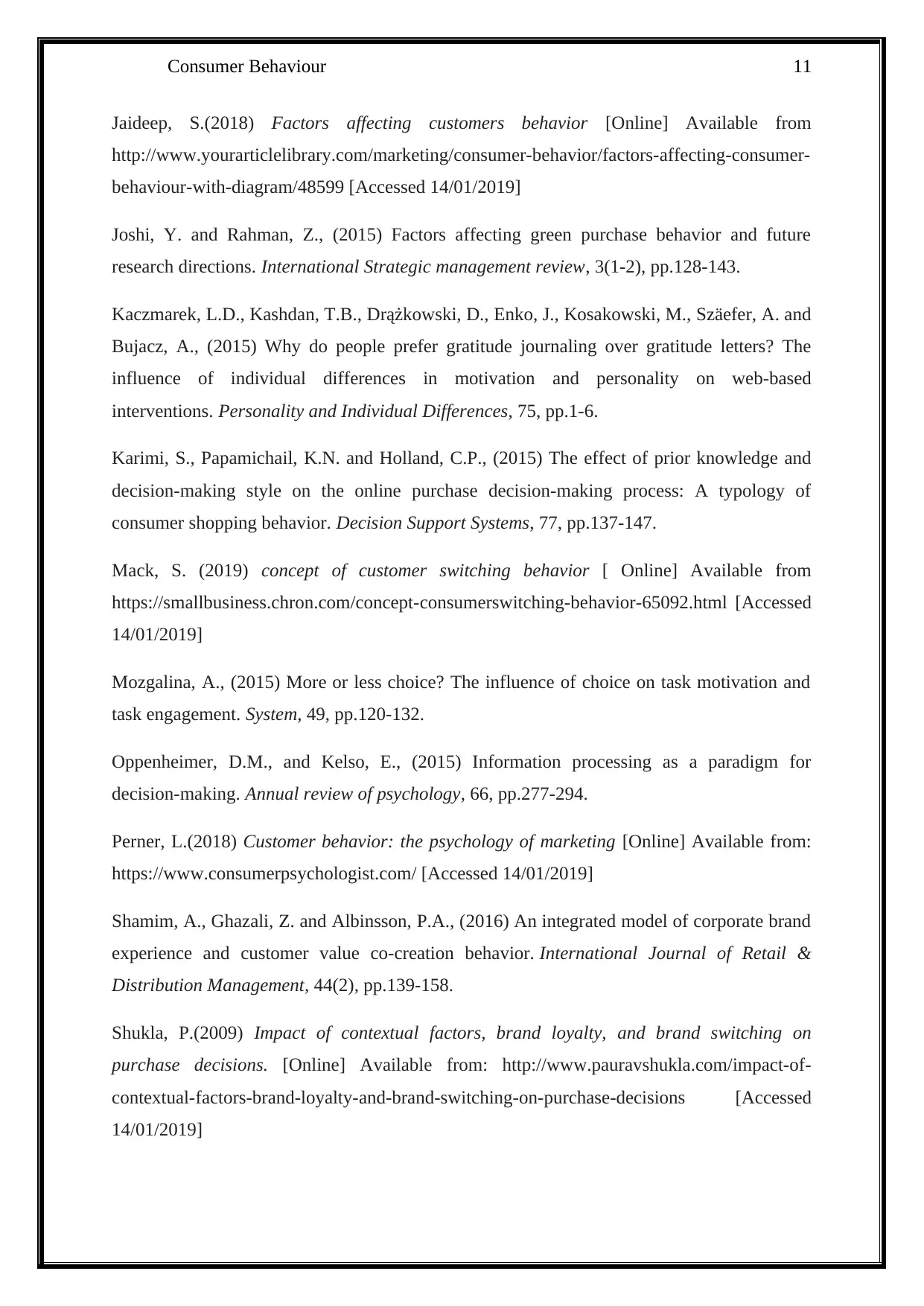
Consumer Behaviour 11
Jaideep, S.(2018) Factors affecting customers behavior [Online] Available from
http://www.yourarticlelibrary.com/marketing/consumer-behavior/factors-affecting-consumer-
behaviour-with-diagram/48599 [Accessed 14/01/2019]
Joshi, Y. and Rahman, Z., (2015) Factors affecting green purchase behavior and future
research directions. International Strategic management review, 3(1-2), pp.128-143.
Kaczmarek, L.D., Kashdan, T.B., Drążkowski, D., Enko, J., Kosakowski, M., Szäefer, A. and
Bujacz, A., (2015) Why do people prefer gratitude journaling over gratitude letters? The
influence of individual differences in motivation and personality on web-based
interventions. Personality and Individual Differences, 75, pp.1-6.
Karimi, S., Papamichail, K.N. and Holland, C.P., (2015) The effect of prior knowledge and
decision-making style on the online purchase decision-making process: A typology of
consumer shopping behavior. Decision Support Systems, 77, pp.137-147.
Mack, S. (2019) concept of customer switching behavior [ Online] Available from
https://smallbusiness.chron.com/concept-consumerswitching-behavior-65092.html [Accessed
14/01/2019]
Mozgalina, A., (2015) More or less choice? The influence of choice on task motivation and
task engagement. System, 49, pp.120-132.
Oppenheimer, D.M., and Kelso, E., (2015) Information processing as a paradigm for
decision-making. Annual review of psychology, 66, pp.277-294.
Perner, L.(2018) Customer behavior: the psychology of marketing [Online] Available from:
https://www.consumerpsychologist.com/ [Accessed 14/01/2019]
Shamim, A., Ghazali, Z. and Albinsson, P.A., (2016) An integrated model of corporate brand
experience and customer value co-creation behavior. International Journal of Retail &
Distribution Management, 44(2), pp.139-158.
Shukla, P.(2009) Impact of contextual factors, brand loyalty, and brand switching on
purchase decisions. [Online] Available from: http://www.pauravshukla.com/impact-of-
contextual-factors-brand-loyalty-and-brand-switching-on-purchase-decisions [Accessed
14/01/2019]
Jaideep, S.(2018) Factors affecting customers behavior [Online] Available from
http://www.yourarticlelibrary.com/marketing/consumer-behavior/factors-affecting-consumer-
behaviour-with-diagram/48599 [Accessed 14/01/2019]
Joshi, Y. and Rahman, Z., (2015) Factors affecting green purchase behavior and future
research directions. International Strategic management review, 3(1-2), pp.128-143.
Kaczmarek, L.D., Kashdan, T.B., Drążkowski, D., Enko, J., Kosakowski, M., Szäefer, A. and
Bujacz, A., (2015) Why do people prefer gratitude journaling over gratitude letters? The
influence of individual differences in motivation and personality on web-based
interventions. Personality and Individual Differences, 75, pp.1-6.
Karimi, S., Papamichail, K.N. and Holland, C.P., (2015) The effect of prior knowledge and
decision-making style on the online purchase decision-making process: A typology of
consumer shopping behavior. Decision Support Systems, 77, pp.137-147.
Mack, S. (2019) concept of customer switching behavior [ Online] Available from
https://smallbusiness.chron.com/concept-consumerswitching-behavior-65092.html [Accessed
14/01/2019]
Mozgalina, A., (2015) More or less choice? The influence of choice on task motivation and
task engagement. System, 49, pp.120-132.
Oppenheimer, D.M., and Kelso, E., (2015) Information processing as a paradigm for
decision-making. Annual review of psychology, 66, pp.277-294.
Perner, L.(2018) Customer behavior: the psychology of marketing [Online] Available from:
https://www.consumerpsychologist.com/ [Accessed 14/01/2019]
Shamim, A., Ghazali, Z. and Albinsson, P.A., (2016) An integrated model of corporate brand
experience and customer value co-creation behavior. International Journal of Retail &
Distribution Management, 44(2), pp.139-158.
Shukla, P.(2009) Impact of contextual factors, brand loyalty, and brand switching on
purchase decisions. [Online] Available from: http://www.pauravshukla.com/impact-of-
contextual-factors-brand-loyalty-and-brand-switching-on-purchase-decisions [Accessed
14/01/2019]
⊘ This is a preview!⊘
Do you want full access?
Subscribe today to unlock all pages.

Trusted by 1+ million students worldwide
1 out of 13
Related Documents
Your All-in-One AI-Powered Toolkit for Academic Success.
+13062052269
info@desklib.com
Available 24*7 on WhatsApp / Email
![[object Object]](/_next/static/media/star-bottom.7253800d.svg)
Unlock your academic potential
Copyright © 2020–2025 A2Z Services. All Rights Reserved. Developed and managed by ZUCOL.



